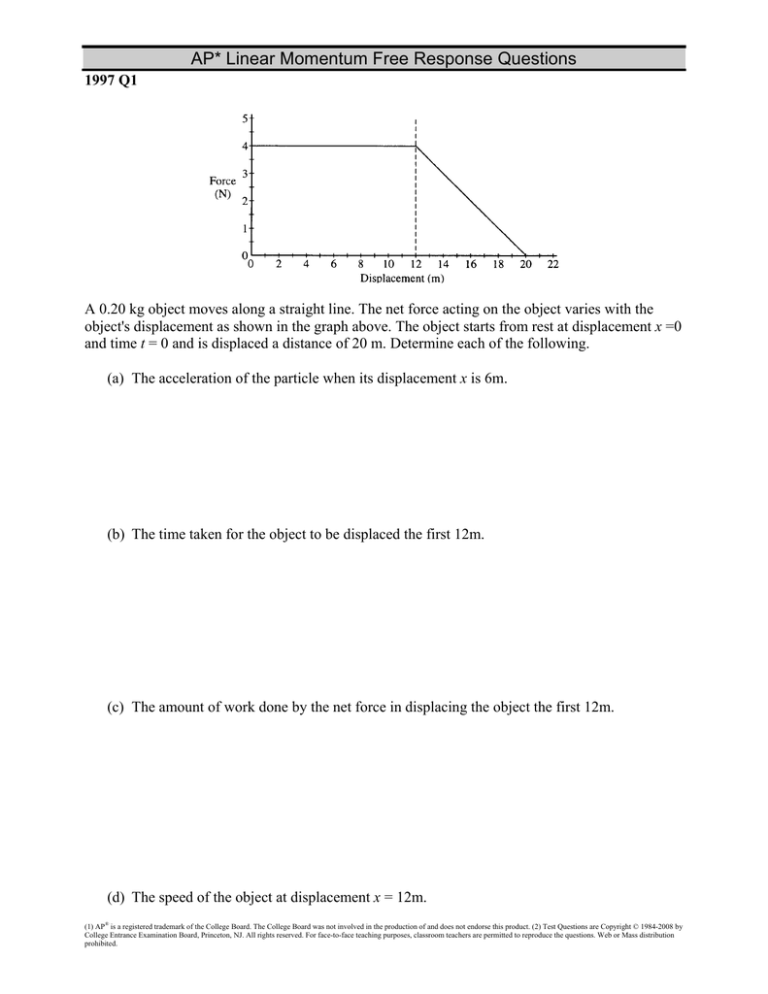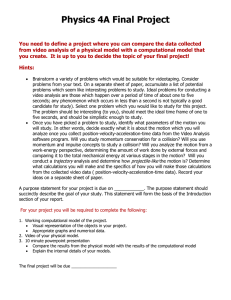
AP* Linear Momentum Free Response Questions
1997 Q1
A 0.20 kg object moves along a straight line. The net force acting on the object varies with the
object's displacement as shown in the graph above. The object starts from rest at displacement x =0
and time t = 0 and is displaced a distance of 20 m. Determine each of the following.
(a) The acceleration of the particle when its displacement x is 6m.
(b) The time taken for the object to be displaced the first 12m.
(c) The amount of work done by the net force in displacing the object the first 12m.
(d) The speed of the object at displacement x = 12m.
(1) AP® is a registered trademark of the College Board. The College Board was not involved in the production of and does not endorse this product. (2) Test Questions are Copyright © 1984-2008 by
College Entrance Examination Board, Princeton, NJ. All rights reserved. For face-to-face teaching purposes, classroom teachers are permitted to reproduce the questions. Web or Mass distribution
prohibited.
AP* Linear Momentum Free Response Questions
page 2
(e) The final speed of the object at displacement x = 20m.
(f) The change in the momentum of the object as it is displaced from x = 12m to x = 20m
AP* Linear Momentum Free Response Questions
page 3
1992 Q2
A 30-kilogram child moving at 4.0 meters per second jumps onto a 50-kilogram sled that is
initially at rest on a long, frictionless, horizontal sheet of ice.
(a) Determine the speed of the child-sled system after the child jumps onto the sled.
(b) Determine the kinetic energy of the child-sled system after the child jumps onto the sled.
AP* Linear Momentum Free Response Questions
page 4
After coasting at constant speed for a short time, the child jumps off the sled in such a way that she
is at rest with respect to the ice.
(c) Determine the speed of the sled after the child jumps off it.
(d) Determine the kinetic energy of the child-sled system when the child is at rest on the ice.
(e) Compare the kinetic energies that were determined in parts (b) and (d). If the energy is
greater in (d) than it is in (b), where did the increase come from? If the energy is less in (d)
than it is in (b), where did the energy go?
AP* Linear Momentum Free Response Questions
page 5
2008B Q1 (10 points)
A 70 kg woman and her 35 kg son are standing at rest on an ice rink, as shown above. They push
against each other for a time of 0.60 s, causing them to glide apart. The speed of the woman
immediately after they separate is 0.55 m/s. Assume that during the push, friction is negligible
compared with the forces the people exert on each other.
(a) Calculate the initial speed of the son after the push.
(b) Calculate the magnitude of the average force exerted on the son by the mother during the
push.
AP* Linear Momentum Free Response Questions
page 6
(c) How do the magnitude and direction of the average force exerted on the mother by the son
during the push compare with those of the average force exerted on the son by the mother?
Justify your answer.
(d) After the initial push, the friction that the ice exerts cannot be considered negligible, and
the mother comes to rest after moving a distance of 7.0 m across the ice. If their
coefficients of friction are the same, how far does the son move after the push?
AP* Linear Momentum Free Response Questions
page 7
1996 Q1 (15 points)
Two identical objects A and B of mass M move on a one-dimensional, horizontal air track. Object
B initially moves to the right with speed v0. Object A initially moves to the right with speed 3 v0, so
that it collides with object B. Friction is negligible. Express your answers to the following in terms
of M and v0.
(a) Determine the total momentum of the system of the two objects.
(b) A student predicts that the collision will be totally inelastic (the objects stick together on
collision). Assuming this is true, determine the following for the two objects immediately
after the collision.
i.
The speed
ii.
The direction of motion (left or right)
When the experiment is performed, the student is surprised to observe that the objects separate
after the collision and that object B subsequently moves to the right with a speed 2.5 v0.
AP* Linear Momentum Free Response Questions
(c) Determine the following for object A immediately after the collision.
i.
The speed
ii.
The direction of motion (left or right)
(d) Determine the kinetic energy dissipated in the actual experiment.
page 8
AP* Linear Momentum Free Response Questions
page 9
1978 Q2
A block of mass M travels horizontally with a constant speed v0 on a plateau of height H until it
comes to a cliff. A toboggan of mass M2 is positioned on level ground below the cliff as shown
above. The center of the toboggan is a distance D from the base of the cliff.
(a) Determine D in terms of v0, H, and g so that the block lands in the center of the
toboggan.
(b) The block sticks to the toboggan, which is free to slide without friction. Determine the
resulting velocity of the block and toboggan.
AP* Linear Momentum Free Response Questions
page 10
1984 Q2
Two objects of masses Ml = 1 kilogram and M2 = 4 kilograms are free to slide on a horizontal
frictionless surface. The objects collide and the magnitudes and directions of the velocities of the
two objects before and after the collision are shown on the diagram above. (sin 37° = 0.6, cos 37°
= 0.8, tan 37º = 0.75)
(a) Calculate the x and y components (px and py, respectively) of the momenta of the two
objects before and after the collision, and write your results in the proper places in the
following table.
(b) Show. using the data that you listed in the table, that linear momentum is conserved in this
collision.
AP* Linear Momentum Free Response Questions
page 11
(c) Calculate the kinetic energy of the two-object system before and after the collision.
(d) Is kinetic energy conserved in the collision?
AP* Linear Momentum Free Response Questions
page 12
1981 Q2
A massless spring is between a 1-kilogram mass and a 3-kilogram mass as shown above, but is not
attached to either mass. Both masses are on a horizontal frictionless table. In an experiment, the
1-kilogram mass is held in place and the spring is compressed by pushing on the 3-kilogram mass.
The 3-kilogram mass is then released and moves off with a speed of 10 meters per second.
(a) Determine the minimum work needed to compress the spring in this experiment.
The spring is compressed again exactly as above, but this time both masses are released
simultaneously.
(b) Determine the final velocity of each mass relative to the cable after the masses are
released.
AP* Linear Momentum Free Response Questions
page 13
1983 Q2
A block of mass M is resting on a horizontal, frictionless table and is attached as shown above to a
relaxed spring of spring constant k. A second block of mass 2M and initial speed v0 collides with
and sticks to the first block. Develop expressions for the following quantities in terms of M, k, and
v0.
(a) v, the speed of the blocks immediately after impact
(b) x, the maximum distance the spring is compressed
(c) T, the period of the subsequent simple harmonic motion
AP* Linear Momentum Free Response Questions
page 14
1985 Q1
A 2-kilogram block initially hangs at rest at the end of two 1-meter strings of negligible mass as
shown on the left diagram above. A 0.003-kilogram bullet, moving horizontally with a speed of
1000 meters per second, strikes the block and becomes embedded in it. After the collision, the
bullet/ block combination swings upward, but does not rotate.
(a) Calculate the speed v of the bullet/ block combination just after the collision.
(b) Calculate the ratio of the initial kinetic energy of the bullet to the kinetic energy of the
bullet/ block combination immediately after the collision.
(c) Calculate the maximum vertical height above the initial rest position reached by the
bullet/block combination.
AP* Linear Momentum Free Response Questions
page 15
2002 Q1 (15 points)
A model rocket of mass 0.250 kg is launched vertically with an engine that is ignited at time t = 0,
as shown above. The engine provides an impulse of 20.0 N s by firing for 2.0 s. Upon reaching its
maximum height, the rocket deploys a parachute, and then descends vertically to the ground.
(a) On the figures below, draw and label a free-body diagram for the rocket during each of the
following intervals.
i.
While the
engine is firing
ii.
After the engine
stops, but before
the parachute is
deployed
iii.
After the
parachute is
deployed
(b) Determine the magnitude of the average acceleration of the rocket during the 2 s firing of
the engine.
AP* Linear Momentum Free Response Questions
(c) What maximum height will the rocket reach?
(d) At what time after t = 0 will the maximum height be reached?
page 16





